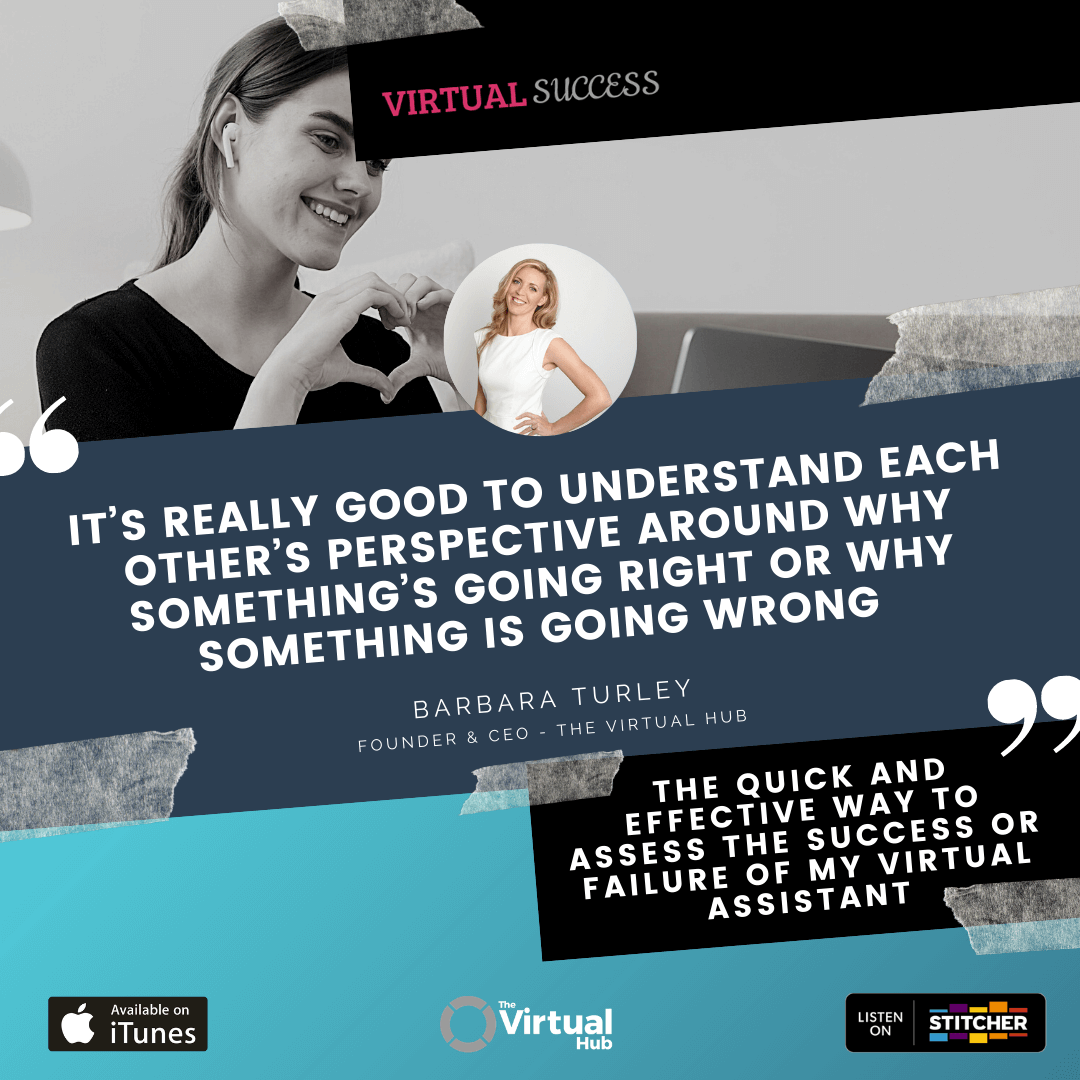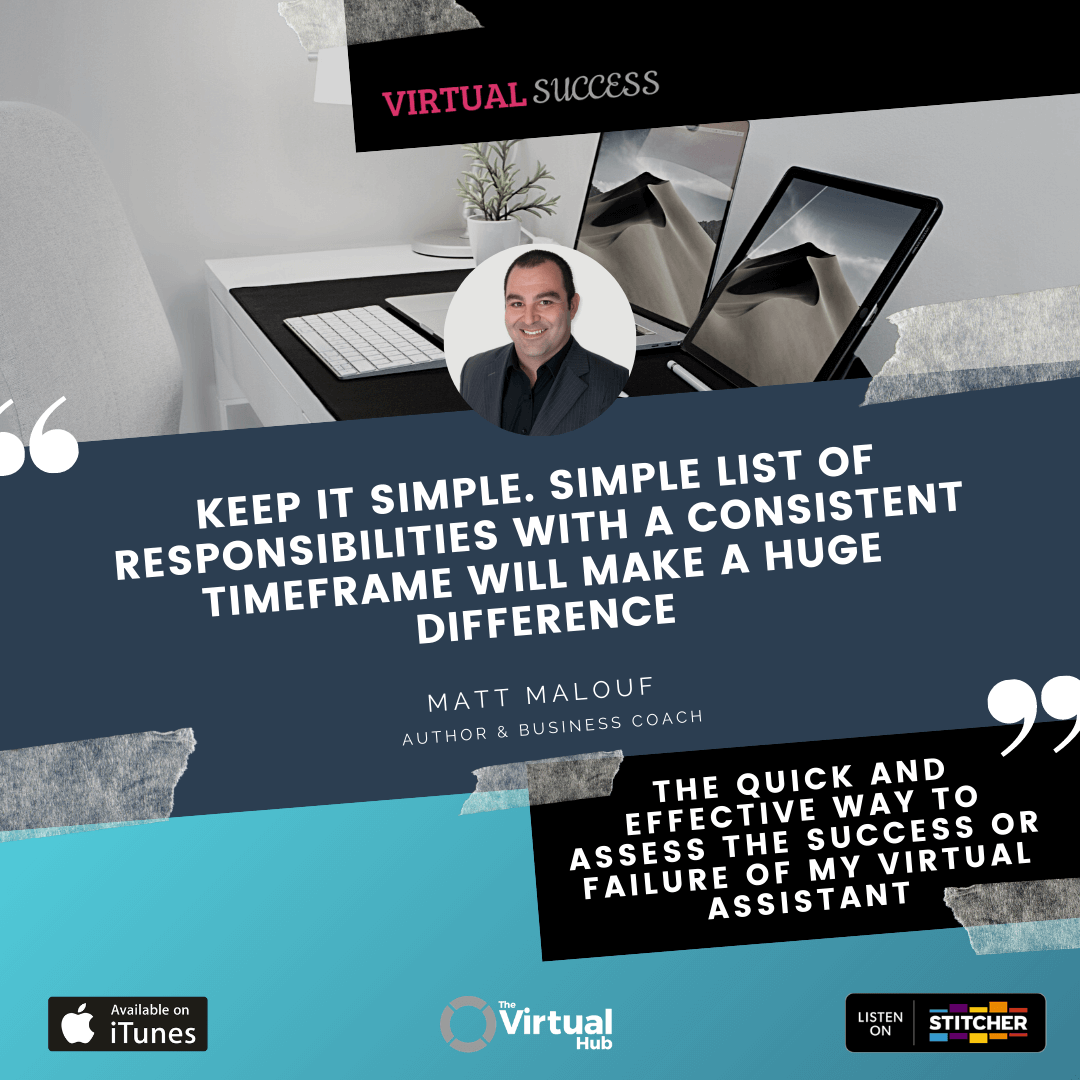The Quick and Effective Way To Assess The Success Or Failure Of My Virtual Assistant
Want the transcript? Download it here.
In this episode, Matt and Barbara talk about the quickest way to assess your Virtual Assistant whether they’re working out for you or not.
Some of the areas covered include:
- The challenges of assessing an offshore VA, identifying the key areas you need to assess! Reviewing your onboarding procedure to make sure you are setting your VA up for success in their role. Continually reviewing and refining your processes.
Let us know what your key takeout has been from this episode and join the continuing conversation over in the Virtual Success Facebook Group.
In this episode:
1:18 How do you assess your Virtual Assistant?
1:52 Biggest Challenges to Assessing Your VA
3:10 Identifying your Key Areas
6:55 Delivering Feedback in An Effective Way
7:42 Identify KPI ‘s
8:14 Assess Your Onboarding Procedure
10:17 Feedback
12:35 The Stop Doing List
14:46 Role Expectations and Communication
16:04 Monthly Assessments
Intro: Do you find yourself running out of time to accomplish your work, are you spending time doing things that you’re not that good at? There are effective ways to outsource these tasks so you can focus on your business. This is the Virtual Success Show, we bring the inside scoop on outsourcing success for entrepreneurs by entrepreneurs. And now here are your hosts Matt Malouf and Barbara Turley.
Matt: Hey everyone, and welcome to another show of the Virtual Success Show where I’m joined by my co-host, Barbara Turley. Hey Barb.
Barbara: Hey Matt. How are you today?
Matt: I’m really well, and yourself?
Barbara: Good, thank you. Excited about our topic that we’re going to dissect into today?
Matt: I am, I am. As always, meetings before the show are always interesting conversations and topics just pop up. This one, it was funny. We were halfway through a conversation, Barbara and I, and we went, “This is a show, let’s start recording.” So we did.
Barbara: So here we are, to dissect what the problem I presented to Matt is…
How Do You Assess Your Virtual Assistant?
Matt: And it is. I think one of the questions I get asked regularly is how do I assess or measure the success or failure of my virtual assistant? How do I know whether they’re doing well or not doing well? It’s a really interesting topic. I think there’s many many different ways you can do this. But what we wanted to do today was open a discussion between Barbara and I because we were talking about this beforehand, and then we share some insights into this. I think one of the biggest challenges when trying to assess your virtual assistant is making it really complicated and then therefore hard to measure and be transparent. When you try to measure the success or failure of a role, you’ve got to make it really easy and transparent for both you and the persons you’re assessing to understand how they’re doing. There should be no surprises.
Biggest Challenges to Assessing Your VA
Matt: The way that I’ve done this over the years with the virtual teams and even local people that I’ve had working with me, I create a list of the things that they are responsible for. For instance, they may be responsible for managing my calendar, managing my emails, booking hotels, booking travel. One for Barbara and I is the podcast, so actually taking the recordings and producing the show. You need to create a list of all of the key areas or key responsibilities that your VA has. What you then need to do is you need to get them to score themselves, let’s say it’s a scoring system out of five, and five is that they are completely competent, confident, and do this task exceptionally well, and one is that they’re a novice at it, that they really don’t know what they’re doing and are struggling with it.
Identifying your Key Areas
Matt: You get them to assess themselves in each of those areas as a score out of five. What you then do separately is you take the same list and you score them on how you believe they’re doing with that responsibility or that task. Then what you can do is you can have a really educated and robust conversation about the gap. For instance, I’ll just use the example of managing my calendar, and let’s say I score my virtual assistant as a three and they score themselves as a four. Then the discussion is why do they give themselves a four and why did I give them a three, and then what are we going to do differently in the next month or quarter depending on what period of time you’re reviewing to get them to a four or a five? That way then you’re understanding from their model of the world how they assess themselves and they understand from your model of the world how you assess them… what are your thoughts around that Barb?
Delivering Feedback in An Effective Way
Barbara: Yeah, I was just thinking as you’re talking. What I love about that set up is that you get to the heart of things that are difficult to identify. For example, you as the business might say, “Yeah, you do a great job with the calendar management, I understand you’re there every day, you get back to the clients, everything’s always correct,” so I’m just trying think of an example of where you could dig into something that’s frustrating you that you haven’t been able to articulate or even realize before. You might say to the VA, “The only thing is though you’re constantly pinging every 10 minutes in Skype with questions about the calendar,” and that’s where the disconnect is. From their perspective, the calendar looks good, everything’s right, but they’re getting constant clarifications or whatever. There’s something that’s slightly outside of the task that is frustrating you and therefore causing your view of the task’s success in this scenario to be skewed negatively so that neither of you can.

That, as you say, that means the VA can see it from your perspective and you can see it from their perspective. As we know, generally we all view things differently. It’s really good to understand each other’s perspective around why something’s going right or why something is going wrong from the other person’s perspective. I think that is a really powerful conversation actually, and it reduces any negativity that people feel around feedback. As we know, we did a series of shows on this before. Delivering feedback in an effective way can be quite awkward for many people, and they feel it’s quite negative. And this is much more collaborative conversation around what’s needed by both sides.
Matt: Yes. Also to add to that, one of the earlier shows we did around expectations. What could happen is they could understand the task, but your expectation and their expectation may be misaligned. It’s often through what hasn’t been communicated.
Identify KPI ‘s
Barbara: Yeah, and you only learn that by working together actually, each other’s style. That can really affect how things … But we were talking about KPIs basically, Matt and I, and while we did identify certain KPIs that you could use that are very metrics driven, of course, that’s the ideal pure way of doing this, but doing it that way can lose some of the stuff we were just talking about here. Matt, I’m just thinking you lose that connectivity of style and perspective and that conversation gets lost…
Assess Your Onboarding Procedure
Matt: It does, it does. What this also does, as a business owner and an entrepreneur, it enables you to assess your effectiveness of onboarding and training your staff also. I’ve always found in the past where the gap often lies is because I haven’t trained my virtual assistant in the ways that I’m actually expecting them to do something, or I’ve only trained them in certain parts of it and I haven’t actually gone to the next level with the training. But also too, I may have trained them in something, but haven’t spent enough time practicing it with them, or enabling them to ask me questions, or maybe I rushed the training. There’s so many different things, and if we’re going to take responsibility around here, this is not an assessment tool to point the finger. It’s an assessment tool to be able to work together so that you get the best from this role and this person.
Barbara: I’m thinking as well, some of you guys listening will be thinking, “Oh my God, that just sounds so tedious, it’s like an HR role, I don’t want to do this.” But most of us, being entrepreneurial quite frankly would rather stick needles in our eyeballs than do this sort of analysis and team management, but sadly when you’re running a business, whether you like it or not, I think this becomes part of your role as a leader, even if you just bring one VA into your business. You can choose to not do it, but I think the power of doing it is that you start to invest in your people. That, I can safely say that’s one of the most powerful things that I have done in my business is to help my people be great regardless of how great they were before. They might have been A players coming in, but I need them to be my A players, and it does really help to get this right.
Feedback
Matt: Yeah. But also too, what I think you’ve got to remember is everyone needs feedback. If I’m not getting feedback from whether it’s my superior or whoever it might be, I’m going to assume I’m doing a good job because I haven’t heard anything, I’m not being told otherwise, I’m doing the tasks that are asked of me. I’m just going to assume that I’m doing things the way that I should be or the way that are expected of me.
Barbara: Or… some people might be thinking, “Well, they haven’t pinged me for it, so nobody’s noticing that I’m not doing a good job.” For those people that know that they’re not really playing at the level, they’re skirting under the wire so to speak, if you have that type of person on your team, they’ll just keep skating along if they feel they can get away with it.
Matt: I think consistent and timely feedback, and also to having a… When I conceptualize this with my VA years ago, it was because I wanted to see how they assess themselves as well as I did. I mean I could assess them, but I knew that if we discussed the gap, then at least what I find anyway is that they don’t get defensive, because it’s a constructive conversation. They’ve had the opportunity to give you the score and why they’ve given themselves that score, and you’ve given the opportunity also. What could happen too at times is I’ve had instances where I’ve scored my VA higher then they’ve scored themselves. What it does is it helps build their confidence. It helps reiterate that they’re doing a really good job, and that they are I guess exceeding your expectations. This simple investment of time really does continue to reap and pay you back.
The Stop Doing List
Barbara: In fact, this is actually such a good strategy, Matt, and I’ve heard you talk about it so many times and I read it obviously in your book, The Stop Doing List. Amazing part of that book. We finally, finally, just at this point, we’ve just built it into some of our big system automations that we have around review time and we have an evaluation that goes to the client, to the team leader, and to the VA themselves, across three people. Then it’s we’re including this part where the employee or the virtual assistant gets to rate themselves so that they feel like they’ve got a seat at the table and they actually have a say. I’m interesting to know actually Matt, have you ever had an incident where you rated somebody, they rated themselves higher than you did, but upon discussion, you realized that maybe their rating actually was right and yours was skewed in the wrong direction for whatever reason? Has that ever happened?
Matt: It has, yeah. And often it’s because either the parts that I was saying they weren’t doing had never been communicated with them…trained in those areas, or that responsibility, it may have been that we had three responsibilities in one, so it wasn’t clear that I was responsible for all three things. I thought I only needed to do this part.
Barbara: I was just thinking, that’s a great example actually. Now that I’ve asked that question, I’m actually thinking that happens more often than we think. I had a situation a while ago where I probably was consistently rating one of my team lower than this person would rate themselves. And then it became apparent to me when I thought about it, I actually spoke to HR and I had some feedback from other people who interact with this role that that person saw themselves as supporting me as opposed to leading that area, and that was an eye-opener for me. I was like, okay, so that person’s expectation of themselves in that role is different from what my expectation of their role is, or the level of leadership that I was attributing to that role was higher than the level of leadership that they thought I was attributing in that role.
Role Expectations and Communication
Barbara: Therefore it resulted in a lot of clarifications, still coming to me for guidance, et cetera, thinking that that was the right thing to do, because I was the leader. And I realized that I hadn’t communicated that effectively, so that was an eye-opener for me to have that experience. There’s multiple ways to look at this process, and it’s not just a cut and dry… you rate yourself, I rate you, and then we discuss and I win, like as the leader my rating stands as the right one.
Matt: Yeah, 100%. What you’ve got to be mindful of here, they score themselves, you score them, you discuss the gap, you need to have clear next steps, and you also have to have a clear timeframe within which you’re going to check back in.
Barbara: Yes. So there’s not left hanging.
Monthly Assessments
Matt: Correct. If this is say a quarterly assessment, I recommend you should do something like this monthly, but at bare minimum quarterly, you might have a difference in writing, but you may say, “What we’re going to do on this particular area, because it’s of high importance, we’re going to check back in in a month. Let’s book it in the diary now so that we can have a little discussion in one month’s time just in this particular area. We’re not going to go through the whole thing again. We’re just going to talk about this particular one because it’s really really important.” Or what you may do is you go, “Okay, there’s a difference. The strategy used that you and I are going to spend some time training together over the next month, I think we need 30 minutes a week. Let’s book it in the diary now and make sure that it happens.”
Barbara: Yeah, and you have to make that commitment. Like I said, as the leader of the business, this is actually a role that you start to take on the minute you start to take people on in your business, and you have to kind of accept that. You can sort of delegate I guess, but until you get really big and you’ve got operations and team leaders and stuff like that, it’s actually hard to delegate this to anyone. You have to suck it up and do it yourself. But you’ll grow your people with it. But for me, it’s great, because this is an area I’ve struggled with myself is to how to progress things. I’ve got all the other strategies down pat as to how to onboard and train and get the most out of VAs, but this is an area now I’m really hitting up against as we’ve had people working with us for years, so we’ve got to do this on behalf of clients as well. We help to mentor the VAs up the ladder too in this way. Really great advice.
Matt: Thank you. Last thing I’d say is just keep this simple. Keep it simple. Simple list of responsibilities with a consistent timeframe and give it a go. It will make a huge difference, and it will help you build a deeper connection and get better results from your VAs.

Barbara: Yes. So if any of you want to share any stories about that, pop into the Facebook group. We’ve got the virtual success Facebook group. And you can also suggest shows that you’d really like us to do. We’re always open to new ideas. If you love the show, please make sure that you share it and subscribe on iTunes or your favorite podcast listening and give us a rating and a thumbs up review if you can so that we can help get the show out to more people. So Matt, thanks so much for that today. Thanks everyone for listening. Until next time.
Matt: Thank you Barb. We’ll see you soon.
Barbara: Bye.
Outro: Thank you for listening to the Virtual Success Show. If you found this show helpful, take a moment to share it with a friend so that we can all grow together.
The Hosts
 Matt Malouf
Matt Malouf
Matt Malouf is a passionate business coach, speaker, author, and entrepreneur on a mission to help entrepreneurs around the world break the shackles of mediocrity and reach new levels of personal and business success.
 Barbara Turley
Barbara Turley
Barbara Turley is the Founder & CEO of The Virtual Hub, a company that specializes in recruiting, training, and managing superstar ‘Virtual Assistants’ in the social media, digital marketing, and systems automation space.
